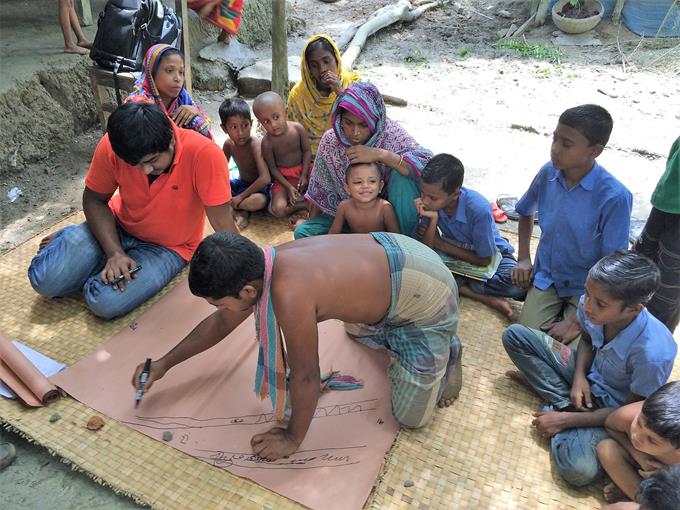Verbal and social autopsy
Method
Verbal autopsy
A verbal autopsy is a face-to-face method of data collection which can be used to document unregistered deaths. This is useful in low-income settings where barriers to accessing healthcare services result in many deaths occurring in community settings where they are not medically certified or registered. This is particularly relevant for drowning-related deaths, which often occur in community settings at the time of the drowning event and are not registered through any administrative systems.
To perform a verbal autopsy, researchers travel door-to-door within a community completing a questionnaire which retrospectively documents deaths of household members over a set period of time. For each death reported, the family members, carers, friends and/or neighbours of the deceased recall the persons’ experiences directly prior to their death. This can include symptoms or the details of an accident. For fatal drowning cases, detailed information can be collected on the sociodemographic characteristics of the deceased, on the place, time, intent and activity at the time of the drowning event, and details on any treatment sought or healthcare service use post drowning event. These findings are then either reviewed by a team of physicians or analysed using statistical methods to determine a clinical cause of death for each mortality reported.
- Questionnaires used for conducting verbal autopsies generally include a list of causes of death and a list of diagnostic criteria. Both are used to confirm clinical cause of death
- The questions included should mostly be closed-ended consisting of ‘yes’ or ‘no’ answers to simplify analysis, particularly if statistical methods are used
- Ideally, two physicians will independently review data from each verbal autopsy to determine cause of death for each fatality. If there is a lack of consensus, review by a third physician is required to determine the final result
- It is important to select a relatively short recall time period when asking about past deaths (usually no more than 1 or 2 years), as next of kin may not remember details surrounding the death accurately if it occurred some time ago
Social autopsy
A social autopsy uses similar methods to determine the context surrounding a person’s death, not only the cause. In other words, social autopsies investigate the cultural, social and economic factors that contribute to a fatality. For each identified drowning event, the socioeconomic outcomes experienced by an individual, their family and their community can be explored. This information is rarely available through routinely collected data and can highlight the indirect benefits of investment into drowning reduction initiatives. Social autopsies generally complement verbal autopsies, providing added detail on the deaths reported. Outcomes are useful in identifying a point of intervention for prevention initiatives. They can also be used to identify time points to target for improving recovery following illness or accident.
Advantages
- Provide data that is not routinely collected through health facilities.
- Provide mortality data in settings with limited access to health facilities, where deaths largely tend to occur at home, or where cause of death is rarely documented.
- Can identify health priorities in a population that would otherwise remain undocumented.
- If repeated, can be used to investigate trends in death overtime.
Disadvantages
- Most effective on a population level and is therefore resource intensive.
- Analysing reported signs of illness can be difficult, with accuracy varying with the depth and quality of information provided. This could lead to errors in the classification of cause of death.
- Face-to-face data collection may take time and resources.
- Trained data collectors who are accepted by the sampled population are required due to the intimate nature of door-to-door visits for data collection.
- Data collection can be a highly sensitive task, particularly if the death of a participant occurred recently.
- Computational software may be required for determining cause of death, which may cost money to access.
Context
Verbal and social autopsies are suitable to perform in areas where mortality data is limited or poor quality, and where members of a population are easily accessible. The World Health Organisation has developed a verbal autopsy tool that is recommend for use when documenting drowning cases in these settings.
Examples
Experiences from the national trial of a new verbal/social autopsy tool (Niger): Bensaïd, Khaled, et al. "Verbal/Social Autopsy in Niger 2012–2013: A new tool for a better understanding of the neonatal and child mortality situation." Journal of Global Health6.1 (2016).
Study using verbal/social autopsies to document fatal neonate illness (Bangladesh): Nonyane, Bareng AS, et al. "Factors associated with delay in care–seeking for fatal neonatal illness in the Sylhet district of Bangladesh: results from a verbal and social autopsy study."Journal of Global Health6.1 (2016).
More information
WHO verbal autopsy guide and sample data collection tools (PDF 1,133KB)
Step 1
Assess the situation

